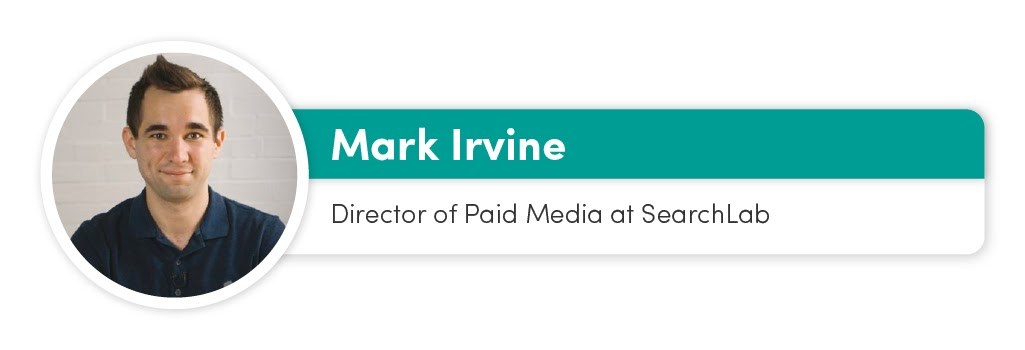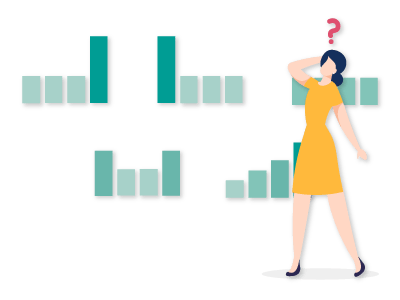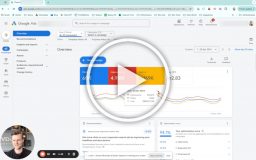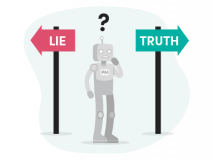Summary
- Targeting consumers early in their customer journey is crucial for success when it comes to scaling your advertising.
- Last-click attribution robs you of essential data about top-of-funnel keywords.
- I recommend using a position-based attribution model for most businesses to get away from Last Interaction.
- If you have access, I advise comparing the data-driven model to position-based and see if it better fits your Google Ads needs.
- Andreas Reiffen: Attribution Modeling is an imprecise science. It’s never the full picture and can’t be.
- Mark Irvine: Review Top Paths and Path Length in Analytics to help form your decision about choosing an attribution model.
- Amy Bishop: There’s no one size fits all attribution model.
- Frederik Hyldig: Remember to differentiate between conversions reported internally by the channel (i.e. inside Google Ads using conversion tracking) and holistically in Analytics.
Because you’re reading this article, I assume you’re a rather sophisticated marketer or eCommerce business owner. Your PPC campaigns are fairly well built and have given you steady results over time.
You’ve sculpted your campaigns to exactly what your conversion and ROI data have been telling you. But all that has been guiding you in the wrong direction.
In this article, I break down why the default attribution model in Google Ads is horrible for eCommerce stores that want to grow. I will show you the difference between the various attribution models, and lastly, I will recommend what attribution model you should be using if you want to see explosive growth.
What’s the Issue with Last-Click Attribution?
Last Interaction came about with the invention of the Internet (more or less). It was a huge breakthrough at the time:
Are you telling me that I can see which ads result in sales on my website? You gotta be kidding me! THAT’S AMAZING!
It was amazing, but as with everything amazing, it got outdated. Today, we know much more about how consumers buy, but the way of tracking
I’ll give you three key reasons why last interaction is harming your efforts:
1)Remarketing has changed the game. We can now change our bids or even create entire campaigns solely targeting consumers who are in the market for buying the products you sell and have engaged with your website. This is huge. Getting people on your remarketing list is valuable in and of itself, so only giving credit to the last interaction is futile.
2) Customer journeys aren’t 1:1. It’s never one keyword that’s responsible for a purchase. Accrediting the entire value of a sale to the last keyword someone is using is inaccurate, plain and simple.
3) You’re still tracking sales when you change your attribution model. Changing your attribution model doesn’t mean you’re attributing value to actions on your website that aren’t revenue-driving.
Overview of Attribution Models
“First Touch”
Credits 100% of value to the first touch.
Pros:
Feeds people into your Sales funnel. Great for stores with very strong sales funnels and few products.
Cons:
If multiple searches are made along the customer journey, you will likely miss the user as they make additional searches
“Last Touch”
Credits 100% of value to the last touch.
Pros:
Focused on touchpoints with high ROI. Decent for stores with short buying cycles (less than a day).
Cons:
Missed opportunities for influencing buyers early in the funnel, which might cause you to lose them later in the funnel.
Linear
Credits equal value to all touchpoints.
Pros:
All touch points are considered.
Cons:
Overvalues mid-funnel touchpoints, which makes efficient bid management difficult.
Not ideal for PPC.
Time-Decay
Mainly credits to last touch, but allows for some credit to touch points up to conversion.
Pros:
Heavy efficiency, but still allows some room for value to be credited to other touchpoints. Great “intro” to other attribution models.
Cons:
Undervalues the value derived from the initial touchpoint. Especially for stores selling higher-end items.
Position-Based
Credits 40% to first touch, 40% to last touch and spreads 20% equally to the rest.
Pros:
Near perfect accreditation, to the first touchpoint, while crediting value to the high-efficiency touchpoint right before a purchase.
Cons:
Might undervalue important mid-funnel touchpoints that are crucial to the decision
(for PPC this is less relevant).
Data-Driven
Credits everything algorithmically.
Pros:
It’s customized to the exact customer journeys that your specific customers take.
Cons:
It’s a black box that you don’t know how works. If your data says one thing, but you want to force another direction, you can’t.
Compare Your Data in Different Attribution Models
Changing your attribution model can feel like a shot in the dark. You’re not sure what will change and you have a lot of money riding on the decision. It’s everything from where you allocate your ad spend to how revenue each channel generates.
But, no eCommerce stores would ever run into any serious issues by changing the attribution model. The biggest impact would be if you changed from last-click to first-interaction. That might be a bad idea, but it wouldn’t bankrupt your business.
Luckily you don’t have to guess what the impact will be.
In order to make it easier for you to predict what will happen when you change your attribution model, Google actually made a tool.


In the example above, you can see the effect changing to first-interaction would have on an account. Some campaigns suddenly accounted for 15-35% more revenue than previously reported.
Not Seeing Any Meaningful Differences Between Last-Click and the Other Models?
Such a scenario is not unheard of and I’ll admit that the first couple of times I opened a client account after “pitching” the great need for a new attribution model just to see that there weren’t any real meaningful difference when comparing the different models, I froze.
Then I started looking at their overall marketing portfolio and the reason was clear. They had optimized their marketing based on a last-click model for years.
This meant that they had cut off any channels or keywords that didn’t generate a sale “last-click style”. By doing this, they had cut off the majority of the TOFU (top of funnel) channels/keywords from their marketing.
If that’s the case for you, then you might have an obvious opportunity to expand your PPC campaigns towards middle and top-of-the-funnel keywords.
My Recommended Attribution Models
When I first started investigating attribution models I read blog post after blog post that explained what attribution meant, but not a single blog post recommended an actual attribution model.
I eventually developed some guidelines for SavvyRevenue’s clients, but I was surprised with how few people actually recommended or gave guidelines surrounding attribution models.
Below, you’ll find my recommendations for when to use the different attribution models:
Position-Based for Most eCommerce Stores
The position-based attribution model is my go-to model these days. Most of the clients in SavvyRevenue choose us for our ability to scale Google Ads accounts beyond where they are today.
In order to do that we’ve recognized the value of driving traffic that eventually contributes to a sale rather than just driving sales.
The difference between the two situations is subtle but important for growing eCommerce stores with PPC. When your tracking attributes value on the first time somebody visits your store then you feed your remarketing, you feed your branding, you feed the amount of people that know you offer this product on the market.
All subsequent times you appear in the SERPs will be influenced by the fact that the visitor had already visited your site once before. For me and my methodology, this is powerful. Especially, as you take into account the increased CTR and Conversion Rate from RLSA.
If you ever think there is an unfair advantage in Google Ads, then it’s your competitors doing this. We catch the buyer early in the funnel and add him to our remarketing lists.
When they then search for the “big buying” keywords, we already know they are active in the market, and we’ve added a positive bid modifier that you can’t compete with.
Use Data-Based If You Have Consistent Access To It
Overall, it looks like a great idea. Google will use their heavy algorithms/machine learning/AI, etc. to find the most common customer journeys and apply the needed value to the various steps in that journey.
All good.
Just two challenges:
1) I’ve seen a couple of cases where eCommerce stores reach the threshold of 600 conversions in 30 days and go straight to the data-based without considering if they will maintain that level of conversions. Often there is a spike in conversion volume at Christmas or Black Friday, which can result in the 600 conversions.
But once the peak season is over the conversion volume goes back to normal, then you will be assigned the linear attribution model.
So if you want to use the data-based attribution model, you will need to make sure you are consistently above the 600 conversion limit.
2) The data-based attribution model is not available outside Google Ads. You will, therefore, be using one model in Google Ads and another in Analytics. This can cause obvious issues as you try to consolidate the data, product reports, or simply just agree whether you hit a target last month.
Use Last-Click If You’re Just Starting Out
I want to make a small case for last interaction if you’re just starting out with your eCommerce store and are limited for funds.
Using last-click when you’re just starting out can help you focus all your budget on keywords that consumers use right before they make a purchase.
Just know that this is a limited strategy it doesn’t scale very well.
Thoughts on Attribution from The Community

I am a strong believer that there is no one perfect attribution method
I am a strong believer that there is no one perfect attribution method. Instead, I suggest using different attribution models to answer different questions (I wrote a blog post with more details a few months back).
Need to know which channels are driving net-new traffic to the site? Check out First Touch.
Need to know which channels are closing sales? Check out Last Touch.
The model should align with the questions that you are trying to ask – and in that process, it should shine a light on whether or not each of your campaigns is performing as intended.
In a high-level analysis of channel contributions, I recommend using a multi-touch model to ensure that you are accounting for the value of all channels.
Rarely would I ever suggest using a single-touch method to analyze overall program performance.
An exception could be made in a situation where budgets are capped and all active campaign spend was intended to drive low-funnel traffic. In that case, a last-touch model could be used to ensure that all campaign spend was effectively driving sales.

All attribution models eventually allocate a completely inaccurate value of a transaction to customer touchpoints
My issue with all attribution models is that they assign credits to touchpoints, which assumes an accurate measurement of the value of a transaction generated by advertising.
Attribution models can help to estimate what percentage of the total value should be assigned to each touchpoint, but the total value itself is inaccurate.
Current attribution systems usually use the revenue as a proxy for the total value, which falls short because:
- If an existing customer completes a transaction, he might have bought anyway, without seeing an ad. Sales to existing customers are never fully incremental.
- It makes a difference if I sell two products that have the same price, but different margins
- Products that are running out of stock don’t require advertising; hence, selling them is less valuable than selling products with excess stock
- Winning new customers who then make repeat purchases is far more valuable than just making revenue with existing customers
- Secondary effects like newsletter signups or referrals are not taken into account
Because of this, all attribution models eventually allocate a completely inaccurate value of a transaction to customer touchpoints. Even Google’s latest stab at data-driven attribution doesn’t take into account the intricacies of product lifecycle management.
I don’t have a favorite attribution model, but any model is only as good as the action you take based on its data.
My top tip is to make sure your bidding systems are able to access the attributed data and optimize based on its results. I’d pay some special attention to retargeting and recommend being skeptical of its benefits.
The key question is to what extent sales through retargeting are incremental and to what extent they would have happened without spending ad money. Incrementality will be different for each business and differ by channel/platform, and therefore needs to be tested carefully.
From the author: Andreas wrote a blog post elaborating on his point. Check out Andreas’ article on Search Engine Land about the subject

Your choice of attribution model comes down to what you want to achieve
Unfortunately, there is still not a perfect solution to attribution. But by exploring all the different attribution models, we can see a situation from different angles.
In the end, your choice comes down to what you want to prove or how aggressive you are in your marketing (last click being most conservative and first click most aggressive).
Personally, I like a position-based model since it gives credit to all the involved clicks, but at the same time, it rewards the initial and the final click the most.
When talking about attribution, it’s always important to remember if you are looking at intra-channel (e.g., conversions reported in Google Ads or Facebook) or multi-channel attribution (conversions in Google Analytics). And also, whether you are looking at cross-device attribution (e.g., Facebook and to some degree also Google Ads) or not (e.g., Google Analytics). We are all still waiting for the perfect solution that brings us both multi-channel and cross-device attribution!

Look in your Time Lag reports for finding your “best” attribution model
I don’t have one specific “favorite” attribution model. Attribution modeling is trying to answer a very broad question about whether or not your advertising is impacting your prospective customers’ behavior, so I think it’s more important to understand your prospective customers’ journey holistically than to marry a specific model. The top paths report is a good place to start to understand that journey:

From there, which model you use will depend a lot on your goals for your campaigns. If your eCommerce goal is simply to just acquire more business, then a time decay model is an easy place to start making smarter decisions. However, if your goal is to attract new customers, you might see the benefit in a position-based model that will credit the campaigns that originally sparked a prospect’s interest.
I think one overlooked report for eCommerce advertisers is the time lag report:

Ecommerce advertisers often rely on remarketing campaigns in their accounts to convert past visitors, but they often don’t know how long to remarket to someone.
The time lag report will clearly highlight how many people convert during the first days and weeks after first arriving at your site and can help you decide how long to set your membership durations within your remarketing campaigns.
Last Thoughts on Changing Your Attribution Model
Attribution models are scary to change. I even thought twice (ok, 5 times) the first time I changed an attribution model. What if I mucked something up?!
I didn’t. And now I’m telling you to do the same without blinking. Changing your attribution model in Google Ads is necessary for you to succeed.
If you’ve ever wondered how your competitors can bid so high for specific keywords, it’s because they have all the potential buyers in their remarketing lists. They know that these people are ready to buy and that they’ve shown interest before. They can therefore bid much more aggressively than you can.













6 thoughts on “Grow Your Google Ads Campaigns by Choosing the Right eCommerce Attribution Model”
I really enjoyed reading the article. Congrats! Already knew all the attribution models and had a clue on what should I use. Now, I’m 100% sure what to use. Thank you for a great return on my time. You worth my time and this comment!
Awesome. Happy to hear you liked the post, Gustavo!
Well explained! Attribution modelling consists of assigning value and credit for conversions and sales exactly across customer touch-points that are most likely to reciprocate with highest returns. It tracks down all the marketing channels where e-com stores invest money in order to generate leads, including paid search, email, social media, display, organic search, referrals etc. You can find more info here: https://bit.ly/2Ezsfim
I blog frequently and I seriously want to thank you for the detailed information. This article has piqued my interest. I’m going to take a note of your site and keep checking for new information about once per week.
I love the content you posted, it is always super helpful and informative. Keep posting such an amazing article, I love reading all your blogs.
thank you for writing about attribution. This has been, and will continue to be, a key topic and challenge for digital marketers… I enjoy every article and conversation on the subject. I believe marketing analytics is one of the most important and not only its important but it also helps in understanding the hidden and potential areas..Good write up